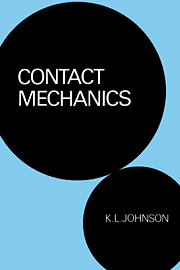Book contents
- Frontmatter
- Contents
- Preface
- 1 Motion and forces at a point of contact
- 2 Line loading of an elastic half-space
- 3 Point loading of an elastic half-space
- 4 Normal contact of elastic solids – Hertz theory
- 5 Non-Hertzian normal contact of elastic bodies
- 6 Normal contact of inelastic solids
- 7 Tangential loading and sliding contact
- 8 Rolling contact of elastic bodies
- 9 Rolling contact of inelastic bodies
- 10 Calendering and lubrication
- 11 Dynamic effects and impact
- 12 Thermoelastic contact
- 13 Rough surfaces
- Appendices
- References and author index
- Subject index
2 - Line loading of an elastic half-space
Published online by Cambridge University Press: 05 June 2012
- Frontmatter
- Contents
- Preface
- 1 Motion and forces at a point of contact
- 2 Line loading of an elastic half-space
- 3 Point loading of an elastic half-space
- 4 Normal contact of elastic solids – Hertz theory
- 5 Non-Hertzian normal contact of elastic bodies
- 6 Normal contact of inelastic solids
- 7 Tangential loading and sliding contact
- 8 Rolling contact of elastic bodies
- 9 Rolling contact of inelastic bodies
- 10 Calendering and lubrication
- 11 Dynamic effects and impact
- 12 Thermoelastic contact
- 13 Rough surfaces
- Appendices
- References and author index
- Subject index
Summary
The elastic half-space
Non-conforming elastic bodies in contact whose deformation is sufficiently small for the linear small strain theory of elasticity to be applicable inevitably make contact over an area whose dimensions are small compared with the radii of curvature of the undeformed surfaces. The contact stresses are highly concentrated close to the contact region and decrease rapidly in intensity with distance from the point of contact, so that the region of practical interest lies close to the contact interface. Thus, provided the dimensions of the bodies themselves are large compared with the dimensions of the contact area, the stresses in this region are not critically dependent upon the shape of the bodies distant from the contact area, nor upon the precise way in which they are supported. The stresses may be calculated to good approximation by considering each body as a semi-infinite elastic solid bounded by a plane surface: i.e. an elastic half-space. This idealisation, in which bodies of arbitrary surface profile are regarded as semi-infinite in extent and having a plane surface, is made almost universally in elastic contact stress theory. It simplifies the boundary conditions and makes available the large body of elasticity theory which has been developed for the elastic half-space.
In this chapter, therefore, we shall study the stresses and deformations in an elastic half-space loaded one-dimensionally over a narrow strip (‘line loading’). In our frame of reference the boundary surface is the x–y plane and the z-axis is directed into the solid.
Information
- Type
- Chapter
- Information
- Contact Mechanics , pp. 11 - 44Publisher: Cambridge University PressPrint publication year: 1985
Accessibility standard: Unknown
- 9
- Cited by
